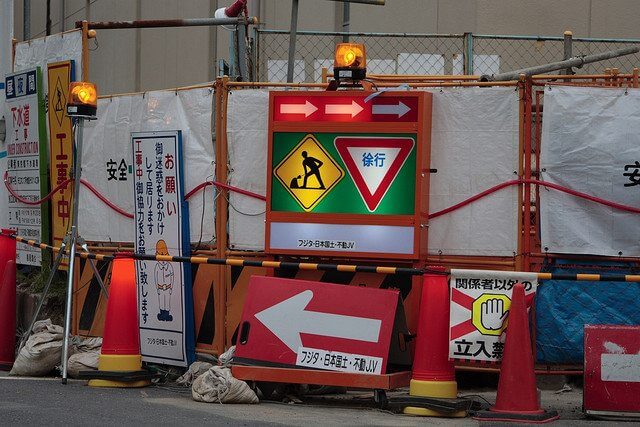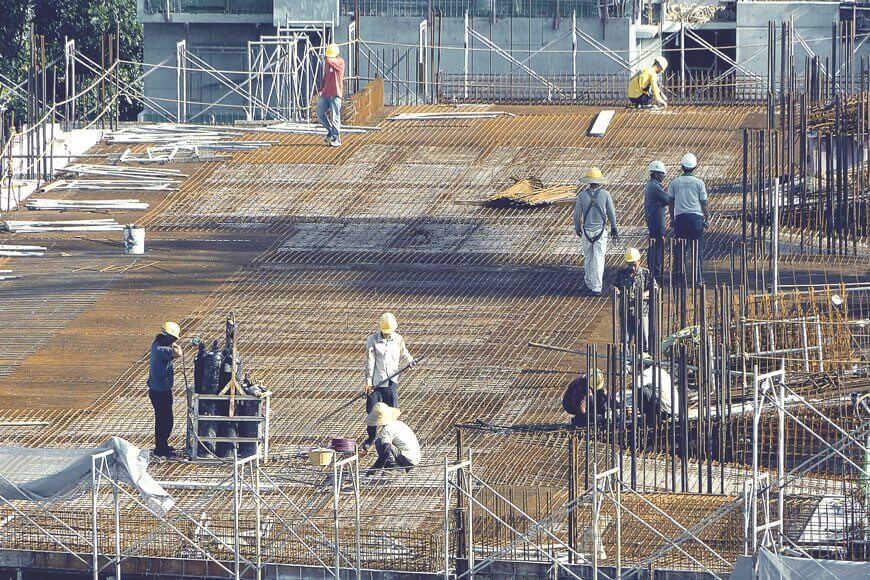McKinsey & Company released a powerful research on the ways in which the construction technology ecosystem is changing. After many years of inertia in the sector, a substantial shift is noticed as the interest in digitisation is rapidly increasing.
The McKinsey & Company research is based on three main pillars, all of them connected to construction innovation and the technology ecosystem: the development of technology clusters, the brave $10 bn investment in the industry during the last decade, and the absence of integration-friendly digital solutions which extend to three major aspects of the construction process: execution on the field, digital collaboration, and back-office.
Without further ado, let’s explore the three main areas of McKinsey’s strategic research:
1. What are the most promising trends based on this year’s study?
In the first part of the research, McKinsey & Company explores how the scenery in the industry has changed in the course of the past year as a result of the following powerful trends: the emergence of technology constellations, a growth of investment, and an increase of use cases.
a) Patterns of solutions are established based on well-analysed use cases
In an effort to understand which type of solutions are gaining momentum in the sector, McKinsey & Company tried to map the full landscape of construction technology based on the various constellations that have lately appeared in the industry.
According to the study, the following constellations are seen as the most influential so far (Exhibit 1):
- Artificial intelligence and analytics
- 3D printing, modularization, and robotics
- Digital twin technology
- Supply chain optimization and marketplaces
In the diagram, prepared by McKinsey & Company, someone can observe that the use cases that are linked together with thick lines are usually addressed collectively. For instance, as it can be seen on the digital twin technology constellation, elements such as virtual learning and design simulation are closely connected due to the steadily rising number of tools that combine these use cases.
From the constellations presented, those who are anticipated to have the biggest impact on the industry are three: digital twin models, AI and analytics, and 3D printing, robotics and modularisation.
As far as the supply chain optimisation and marketplaces constellation is concerned, it has gained significant traction over the past year thanks to the numerous new small and medium players who have come into the field.
b) Evolving and expanding investment in construction technology
Following the growth of investment in construction innovation, McKinsey & Company has eventually come up with two vital remarks:
Over the last ten years investments have increased by 100%: Based on last year’s report, it was shown that ConTech companies have collected approximately $10 bn in investment in the period 2011-2017.
Their newest research revealed that the amount of investment has both grown and accelerated remarkably in the course of the last years. More analytically, the construction technology sector accumulated $9 billion over the period 2008-2012, while this amount took off to $18 billion between 2013 and February 2018. This fundamental increase was fueled to great extent by acquisitions and mergers.
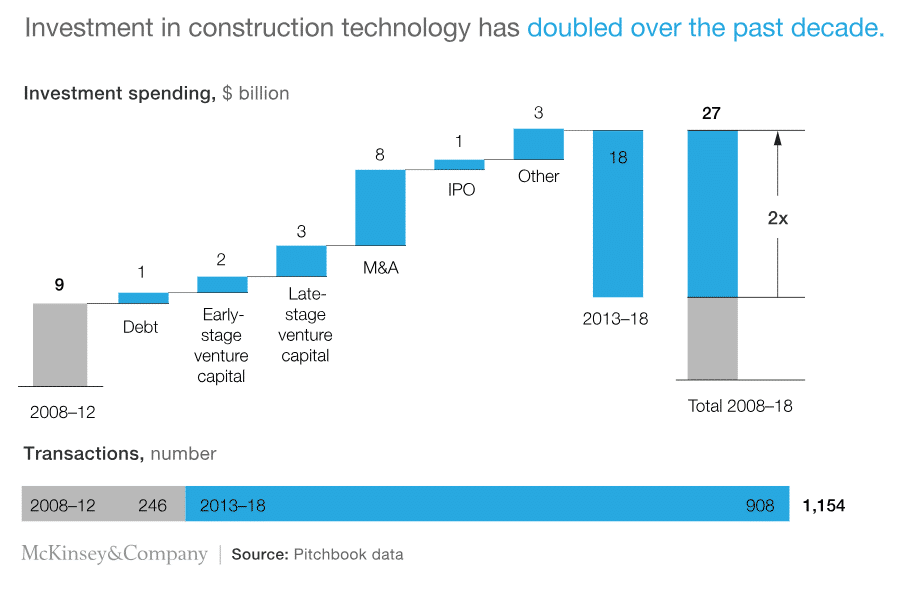
- Photo: McKinsey & Company
Digital solutions are living up to the expectations: The good news for the sector in terms of investment continues, as McKinsey’s research demonstrates. More specifically, it appears that venture capital (VC) is increasing. Between 2013 and February 2018, there have been 908 transactions, and 75% of them were early-stage venture capital.
This trend has increased even further after 2015 and it gives hope that a further development of digital solutions is expected thanks to venture capital. In addition, this steady increase of VC, from 2010 and onwards, is an emphatic proof that there are quite a few use cases that have managed to deliver on their promise. That is an extremely powerful element if we take into consideration the potential that it opens for further development of the sector.
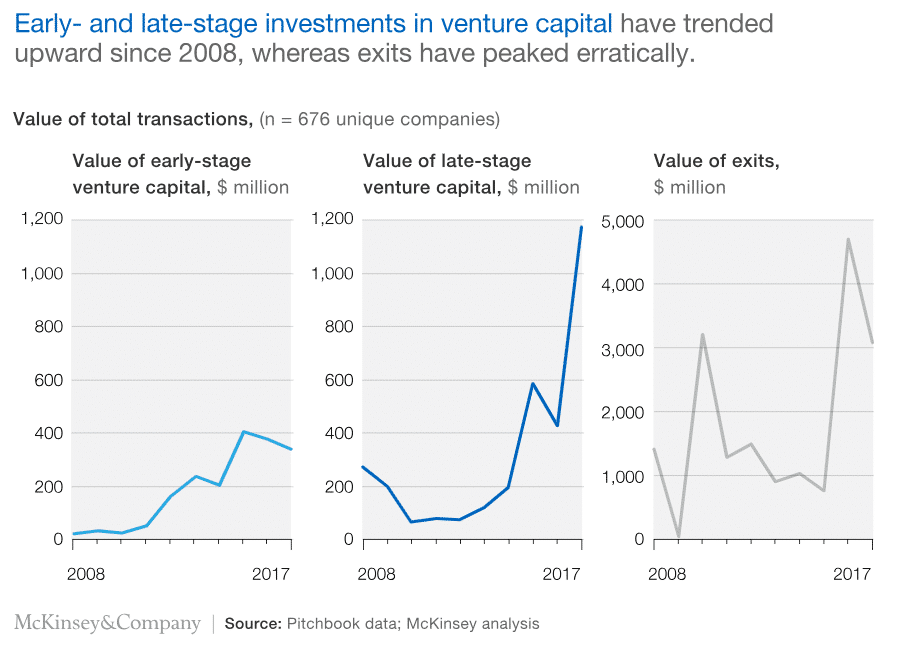
- Photo: McKinsey & Company
c) Increase of use cases
Another interesting and highly promising trend noted by the present McKinsey & Company study had to with the expansion of digital technologies use cases in other aspects of the construction process.
Construction and commissioning was the area of interest that had been initially underlined, but now operations and maintenance are also gaining a lot of growth and momentum. In regard to the other aspects of construction, back-office and pre-construction have already seen some essential progress.
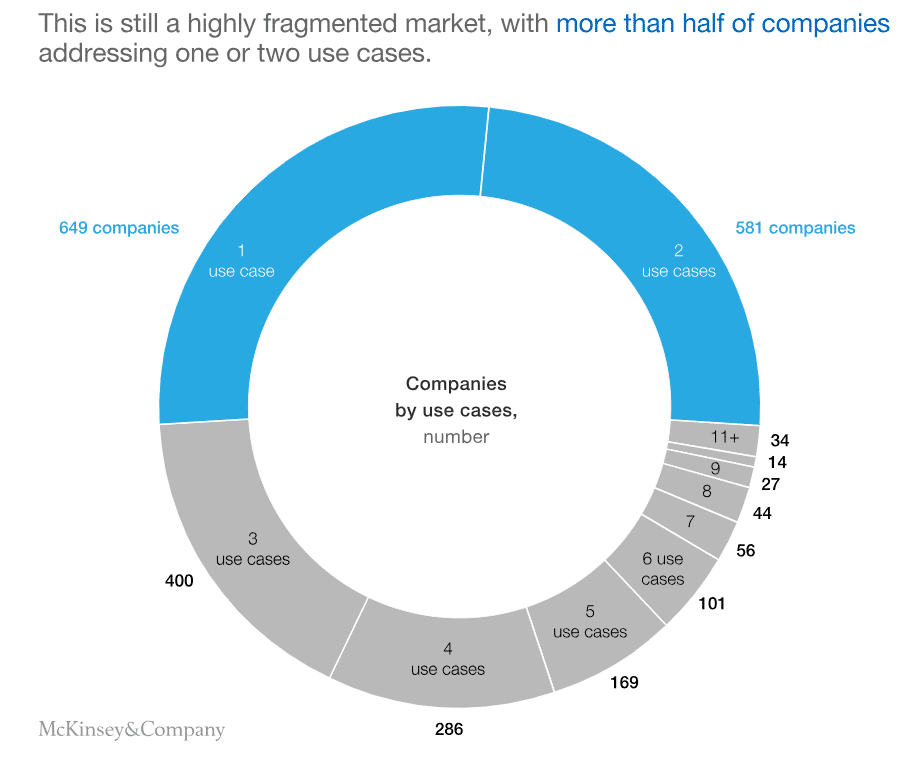
- Photo: McKinsey & Company
2. What’s coming next for the market in the upcoming 2-3 years?
McKinsey & Company were also able to acquire a good understanding of where the industry is heading next. In a nutshell, here are two of the most essential topics of discussion for the entire construction industry in the next 2-3 years:
The construction technology ecosystem will remain fragmented
The fragmentation of digital solutions will continue to be a headache for the sector in the upcoming years. In their 2017 study, McKinsey & Company presented a very disturbing trend of the industry according to which only 13% of the companies had adopted a digital tool which could serve more than one purpose (on-site operation, real-time collaboration, back-office and adjacencies).
This year’s research suggests that more than 50% of the companies are still working with solutions that focus on one or maximum two case uses (out of the 38 listed).
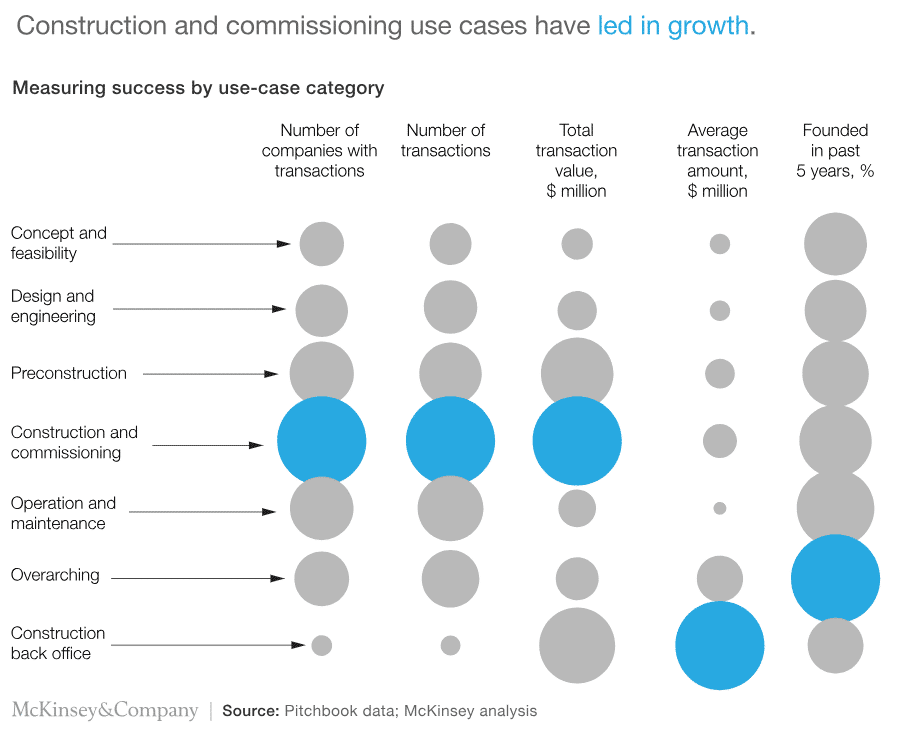
- Photo: McKinsey & Company
It goes without saying that such an approach harms the construction technology ecosystem to a considerable extent. Industry stakeholders need to think ahead and start investing in multi-purpose solutions or in tools which are able to integrate with other solutions. Like that, the establishment of an efficient and open data ecosystem in construction will come one step closer.
The nightmare of talent acquisition
Talent acquisition and retention will remain an issue for the industry in the near future. The role of a fresh and tech-savvy workforce is deemed as imperative for accelerating digitisation in the field.
As reported by McKinsey’s Digital Academy, the advent of digital talent could boost the possibilities of success for digitisation in construction by 2,5 times. Without a doubt, the investment in tech-savvy talent is a demanding process which requires a number of factors to be combined, while keeping in mind at the same time that the talent pool of the sector seems to be pretty limited at this point.
3. How can construction move faster toward the digital era?
No one could deny that the industry has made some brave steps forward during the last decade in terms of building a solid construction technology ecosystem.
Nevertheless, there are still many things that need to be done and it’s the responsibility of everyone in the sector to make them happen. Either we are referring to construction companies, software providers or project clients (owners), these are some substantial actions that they need to materialise soon:
Engineering and Construction firms:
AEC companies are the heart of this sector and it comes as no surprise that they are considered as one of the main pillars for achieving this vital digital shift. According to McKinsey & Company, here is how engineering and construction firms can contribute to the acceleration of the digitisation process for the industry:
Prioritise talent acquisition and training: It is no exaggeration to claim that the construction workforce is one of the decisive drivers for change in the industry. For that reason, AEC firms should invest time and resources both in finding new competent employees as well as expanding the skills set of those who already have.
In order to attract new employees with a strong tech background, engineering and construction companies have to monitor closely other sectors which have recently undergone such a digital transition. Coupling these professionals with the right industry stakeholders can help in integrating processes and methods which could boost digitisation in construction. Such an approach can have a positive influence on how fast construction could become digitised.
Connect with the startup scene: Trying to understand the construction technology startup ecosystem is an excellent idea for AEC firms. They should actively try to connect with ConTech startups and get a mutually beneficial dialogue going.
This linkage between the two sides can take a number of forms, such as direct and indirect investments or strategic partnerships in order to co-develop and test a digital solution.

Pave the way for successful piloting and scaling: Investing in experimentation could also a way for AEC companies to pave the way for digital adoption. To achieve that, it might be a good idea to set a certain amount of their budget aside for that purpose. Once they see some value in their effort, they can proceed further and try to scale it.
Another way they can reach to their goal could be the establishment of partnerships with ConTech startups which can help them build the solutions they have in plan. On top of that, startups could help AEC firms enter in the construction technology ecosystem and become an active part of the change.
Software providers
For tech and software providers that is their big opportunity to come closer to the industry and introduce its stakeholders to the emerging construction technology ecosystem. Here is how they can make it happen:
Listen to the customers’ needs and struggles: One of the most common mistakes done by tech providers is that they neglect to listen to their customers. Instead of taking the time to analyse their pains and common challenges in many cases they choose to create a digital solution that they think it would be nice to have.
That can be highly problematic as it can create a discrepancy between the available solutions and the actual needs of the industry. That being said, it is extremely important for software providers to get closer to the experts of the sector, discuss with them and try to tailor their tool to the sectors’ needs.
Find also: McKinsey & Company – Welcome to the new era of construction technology!
Integrations are your friend: Integrations are also considered to be as one of the secrets for the industry’s future. The development of an open and collaborative construction technology ecosystem can lead to a more efficient sector with fewer rework rates and higher productivity. What is more, startups are going through many strategic changes during the first years and this shifting process can be easier within a thriving data ecosystem.
At the end of the day, though, what’s more important is meeting the needs of your customers. This can be achieved by offering them the flexibility of combining different tools and information sources in order to monitor the progress of their current and future projects.
Clients and owners
Last but certainly not least, clients and owners. They need to take back the control of their projects and start relying on data from past projects so they can move forward. These are the three steps that McKinsey & Company suggests for them:
Enforce a common data environment: All project agents should be able to work on a common shared environment where they can exchange, add or edit data. In other words, a digital backbone is what the project needs. This is something that the project owner should enforce in order to gain a better overview and control over the entire process.
Prioritise the use cases that make sense for your project: Owners should be extra careful with identifying and prioritising the right use cases for their project. The most expensive solution isn’t always necessarily the best way forward. To the contrary, a detailed research is required so that the right solutions are selected. In that manner, owners will be able to plan ahead and do what’s best for their project both in the long and short-run.
Final word
All in all, it is time for the construction industry to embrace digital solutions and introduce them to the different phases of the building process. A paradigm shift is already noticeable and bolder investments, as well as stronger competition, are expected in the near future.
If the sector stakeholders manage to solve the talent acquisition challenge and find a way to the construction technology ecosystem to new limits. One thing is sure. The digital future of construction is on its way, and LetsBuild will be a strong part of it.


